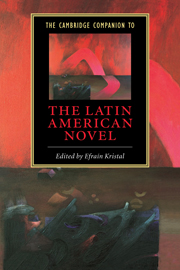Book contents
- Frontmatter
- Introduction
- Part I History
- Part II Heterogeneity
- Part III Gender and sexuality
- Part IV Six novels
- 11 Dom Casmurro by Machado de Assis
- 12 Pedro Páramo by Juan Rulfo
- 13 The Passion According to G.H. by Clarice Lispector
- 14 One Hundred Years of Solitude by Gabriel García Márquez
- 15 The House of the Spirits by Isabel Allende
- 16 The War of the End of the World by Mario Vargas Llosa
- Epilogue
- Bibliography
- Index
- Series List
14 - One Hundred Years of Solitude by Gabriel García Márquez
from Part IV - Six novels
Published online by Cambridge University Press: 28 May 2006
- Frontmatter
- Introduction
- Part I History
- Part II Heterogeneity
- Part III Gender and sexuality
- Part IV Six novels
- 11 Dom Casmurro by Machado de Assis
- 12 Pedro Páramo by Juan Rulfo
- 13 The Passion According to G.H. by Clarice Lispector
- 14 One Hundred Years of Solitude by Gabriel García Márquez
- 15 The House of the Spirits by Isabel Allende
- 16 The War of the End of the World by Mario Vargas Llosa
- Epilogue
- Bibliography
- Index
- Series List
Summary
According to many testimonies, like García Márquez’s exact contemporary the Mexican Carlos Fuentes or the Colombian critic many years younger than both, Michael Palencia Roth, Cien años de soledad (One Hundred Years of Solitude, 1967) is the one novel where Latin Americans recognize themselves instantly: their own social, cultural reality, their families, and the history of their countries. It is also the mirror in which a generation of Europeans and North Americans, by the millions, since its publication have discovered the magical reality of an exotic continent, and a taste for its hallucinatory literature. Are they reading the same novel?
One dimension of the “magical realism” which has been seen to characterize the novel is the simultaneous invocation of different mentalities, genres, sorts of truth and experience. The homely and the banal, the content of the hagiographical and the style of the chronicle come together when the priest can levitate only after imbibing drinking chocolate. A similar combination gives Remedios ascending to heaven and Fernanda’s annoyance at losing her sheets in the ascension. The conjunction of genres generates synesthesia, the mixing of different senses: “un delicado viento de luz” (“a delicate wind of light”). The metaphor and the literal come together when Remedios, as femme fatale, has her suitors die from falls into latrines, kicks to the head from stallions, gun shots. The economic power of the United Fruit Company is translated into meteorological omnipotence when it causes a rainstorm of four years eleven months and two days. One dimension does not cancel or neutralize the other or fuse with it: the prose moves with apparent effortlessness from one to the other, as a Moebius strip.
- Type
- Chapter
- Information
- The Cambridge Companion to the Latin American Novel , pp. 258 - 269Publisher: Cambridge University PressPrint publication year: 2005



